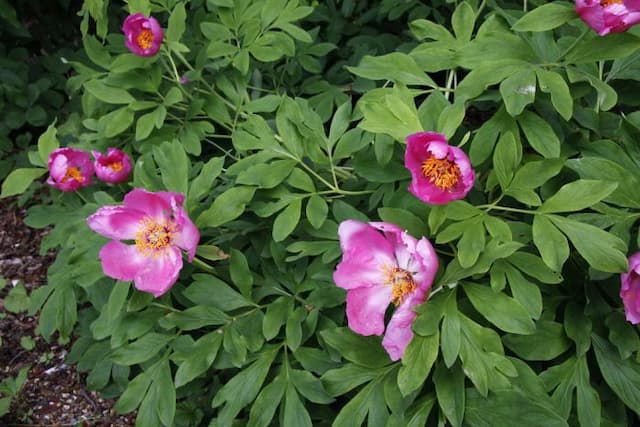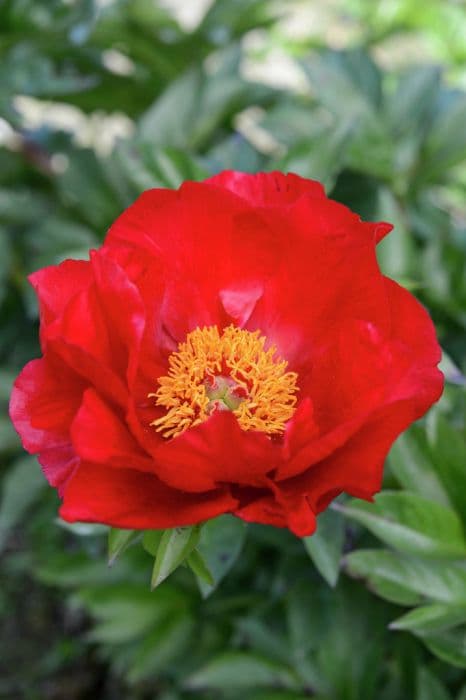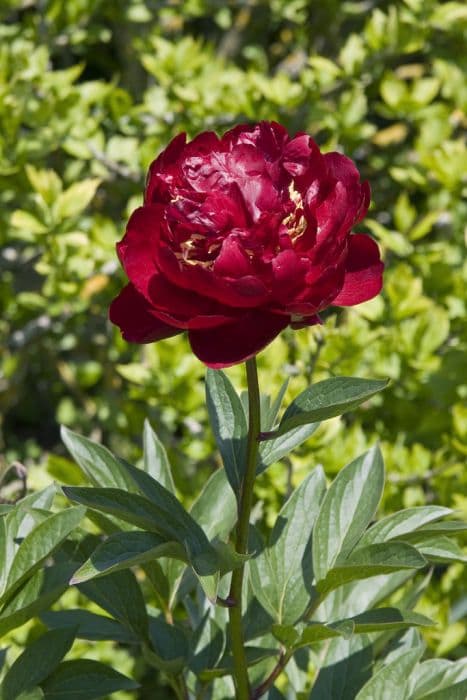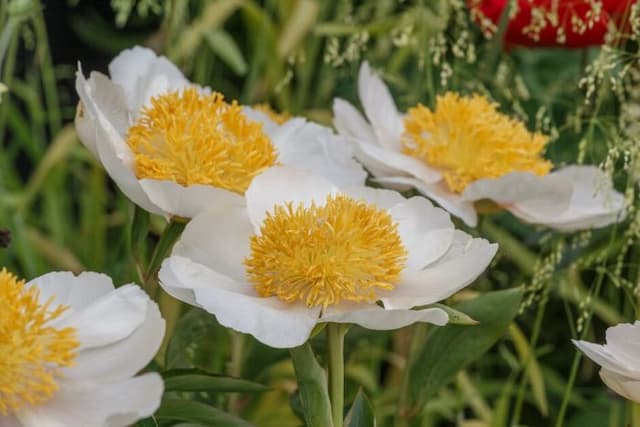Smouth's Peony Paeonia × smouthii

ABOUT
Paeonia × smouthii, commonly known as Smout's Peony, is a hybrid plant known for its striking appearance in the garden. The plant is characterized by its lush, deep green foliage, forming an attractive backdrop for the flowers. The leaves are large and divided into lobes, giving them an ornamental look even when the plant is not in bloom. The flowers of Smout's Peony are the main attraction. They are large and usually double-form, which means they have many layers of petals, giving them a full, ruffled appearance. The petals themselves are silky and delicate, ranging in color from pale pink to deeper shades of pink and sometimes with a hint of cream or white at the base, adding depth and contrast to their overall look. In the center of the flower, a group of golden yellow stamens is often visible, creating an eye-catching contrast against the soft colors of the petals. These stamens are an attractive feature that draws in pollinators. The blooms typically have a rich, sweet fragrance that is highly prized in the garden and when used in floral arrangements. When in full bloom, Smout's Peony has an opulent and romantic presence, with the large, sumptuous flowers sitting atop the sturdy stems, nestled within the dense foliage. The plant has a lush, rounded form, and the flowers tend to droop slightly under the weight of their own beauty, giving the plant a graceful and elegant stance. The overall visual impact of Smout's Peony in the landscape is one of classic beauty and charm, making it a favorite among garden enthusiasts.
About this plant
 Names
NamesFamily
Paeoniaceae
Synonyms
Smouth's Peony
Common names
Paeonia × smouthii.
 Toxicity
ToxicityTo humans
Peonies are not typically considered highly toxic to humans. However, ingestion of parts of the peony plant, especially in large amounts, may cause mild gastrointestinal upset, such as nausea, vomiting, or diarrhea. Skin contact with the sap of the plant can sometimes lead to irritation or rash in sensitive individuals. It is advised to keep peonies out of the reach of children who might accidentally ingest the plant parts.
To pets
Peonies can be toxic to pets if ingested. The most common symptoms of poisoning in pets, such as cats and dogs, after consuming parts of a peony include vomiting, diarrhea, and drooling. In severe cases, ingestion can lead to depression or anorexia. It is best to keep peonies away from pets and to seek veterinary care if you suspect your pet has ingested peony plant material.
 Characteristics
CharacteristicsLife cycle
Perennials
Foliage type
Deciduous
Color of leaves
Green
Flower color
Varies
Height
2-3 feet [60-90 cm]
Spread
2-3 feet [60-90 cm]
Plant type
Shrub
Hardiness zones
Varies
Native area
Cultivar
Benefits
 General Benefits
General Benefits- Aesthetic Value: Paeonia × smouthii, commonly known as Smout's Peony, is valued for its large, showy flowers that add beauty and a focal point to gardens and landscapes.
- Attracts Pollinators: The flowers of Smout's Peony attract bees, butterflies, and other beneficial pollinators, helping to support local ecosystems.
- Cultural Significance: Peonies, including Smout's Peony, often have cultural and historical significance in art, literature, and garden design across various regions.
- Longevity: Smout's Peony plants are known for their longevity, often living for many years, and sometimes for generations, in the same garden spot with proper care.
- Suitable for Cut Flowers: The blooms of Smout's Peony are popular in floral arrangements and can last for a week or more when cut, making them ideal for bouquets and indoor decoration.
- Seasonal Interest: With a blooming period in late spring to early summer, Smout's Peony provides seasonal interest and can be a highlight of the garden during this time.
- Low Maintenance: Once established, Smout's Peony requires relatively low maintenance, which can save time and resources for gardeners.
- Variety in Landscape Design: Available in various colors and forms, Smout's Peony offers a range of options for gardeners looking to design diverse and visually appealing landscapes.
 Medical Properties
Medical Properties Air-purifying Qualities
Air-purifying QualitiesThis plant is not specifically known for air purifying qualities.
 Other Uses
Other Uses- Paeonia × smouthii, commonly known as 'Smouthii', can be used in floral arrangements and bouquets due to its large, attractive blossoms and sweet fragrance.
- The petals of the Smouthii can be used to create natural dyes for fabric, lending a subtle pink hue to textiles.
- The plant's lush foliage can serve as a backdrop in ornamental gardens, providing a rich green contrast to colorful flowering plants.
- Because of their sturdy stems, Smouthii peonies can be used in garden sculptures or living walls to add height and structure.
- After the blooming season, the seed pods of Smouthii can be harvested and used in dried flower crafts and arrangements for their unique shape and texture.
- The plant can serve as a natural caterpillar host, offering a food source for the larvae of some butterfly and moth species.
- In colder climates, the dry stems of Smouthii in winter can be used in garden beds to provide winter interest and habitat for beneficial insects.
- The large leaves of Smouthii can be used in the art of leaf printing, where their veins and shape produce beautiful patterns on paper or fabric.
- During spring festivals or events, fallen Smouthii petals can be scattered along pathways or on water features for a decorative touch.
- Smouthii's upright form can also be used in garden design as a natural fence or boundary, especially when planted in rows or hedges.
Interesting Facts
 Feng Shui
Feng ShuiThe Peony is not used in Feng Shui practice.
 Zodiac Sign Compitability
Zodiac Sign CompitabilityThe Peony is not used in astrology practice.
 Plant Symbolism
Plant Symbolism- Beauty: Peonies are often associated with beauty in its many forms, owing to their lush, full blooms and array of vibrant colors.
- Romance: The peony is frequently used in weddings and romantic bouquets, symbolizing love, affection, and matrimonial bliss.
- Wealth and Honor: In some cultures, especially in China, peonies represent wealth and honor, symbolizing the high value placed on these flowers.
- Good Fortune: Peonies are believed to bring good luck, making them a popular gift for various occasions such as weddings, anniversaries, and significant undertakings.
- Compassion: Sometimes peonies are thought to embody compassion and are given to convey comfort and sympathy to those going through difficult times.
- Happy Life: They are symbolic of a happy life, prosperity, and good health, emblematic of the positive wishes one might have for oneself or others.
- Healing: In traditional medicine, parts of the peony plant are used for healing, translating this practice into a symbolic meaning of healing and recuperation.
 Water
WaterFor a peony, it's important to water deeply but infrequently to encourage strong root growth. When first planting or during the active growing season in spring and fall, water your peony once a week with about 1 inch of water which equals approximately 0.6 gallons for an average-sized plant. During hot, dry spells in the summer, increase watering to twice a week. However, ensure the soil is well-drained as peonies do not like to sit in water-logged soil. Reduce watering after the plant has finished blooming, especially as it approaches dormancy in the fall.
 Light
LightPeonies thrive in a location where they receive full sun to light shade. Ideally, they should receive at least six hours of direct sunlight daily. A spot with morning sunlight and afternoon shade is beneficial in hotter climates, as this helps protect the blooms from intense, midday heat.
 Temperature
TemperaturePeonies are hardy plants that prefer temperate climates with winter chill to thrive and set buds. The ideal temperature range for a peony is between 65°F and 75°F during their growing season. However, they are capable of surviving winter temperatures as low as -20°F and summer highs up to 90°F. Making sure the plant has a period of winter dormancy with temperatures below 40°F is important for bud formation.
 Pruning
PruningPeonies should be pruned to remove spent flowers after blooming to maintain a neat appearance and to prevent seed formation, which can drain energy from the plant. In late fall, after the stems and leaves have turned brown, cut the plant back to ground level. This not only tidies up the garden but also helps prevent overwintering diseases. Peonies do not require regular pruning throughout the growing season unless they are being deadheaded or damaged or diseased stems need to be removed.
 Cleaning
CleaningAs needed
 Soil
SoilPeonies prefer well-draining soil rich in organic matter, with a neutral to slightly alkaline pH of 6.5 to 7.5. For the best soil mix, combine two parts garden soil, one part compost or well-rotted manure, and one part perlite or coarse sand to improve drainage.
 Repotting
RepottingPeonies, including the Smouthii peony, are long-lived perennials and do not need to be repotted often. In fact, they prefer not to be disturbed and may only need repotting if the plant outgrows its location or if the soil becomes exhausted, which can take many years.
 Humidity & Misting
Humidity & MistingSmouthii peonies do not require high humidity and are quite adaptable to the varying outdoor humidity levels found in most temperate climates where they thrive best.
 Suitable locations
Suitable locationsIndoor
Ensure bright light, cool temps, and plant in deep pots.
Outdoor
Plant in sun, well-draining soil, space 3 feet apart.
Hardiness zone
3-8 USDA
 Life cycle
Life cyclePaeonia × smouthii, commonly known as the Smout's peony, begins its life as a seed, which requires a period of cold stratification to break dormancy and germinate. Once germinated, the seedling develops into a juvenile plant, establishing a strong root system and foliage. The plant enters a vegetative stage where it matures and grows leaves and stems annually, emerging from the ground in spring. After several years, the Smout's peony reaches flowering maturity and produces flowers, typically in late spring to early summer, attracting pollinators for sexual reproduction. The flowers are followed by fruit formation, wherein seeds are produced and dispersed, completing the reproductive cycle. During late autumn, the foliage dies back to the ground, and the plant goes dormant over winter, storing energy in the roots for the next growing season.
 Propogation
PropogationPropogation time
Spring to Summer
Propogation: The most popular method of propagation for Paeonia × smouthii, commonly known as Itoh peony or intersectional peony, is division. This is typically performed in the fall, once the plant has gone dormant after the flowering season. Gardeners should carefully dig up the peony clump, ensuring not to damage the roots. The clump can then be gently separated into smaller sections, making sure that each section has at least three to five buds, known as "eyes," and a good amount of root attached. These divisions can be replanted in well-draining soil at a depth where the eyes are about 2 inches (approximately 5 centimeters) below the soil surface. It's crucial to not plant them deeper, as this can affect their blooming. Water the newly planted divisions lightly to settle the soil around the roots and kickstart their growth for the next flowering season.









